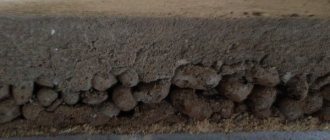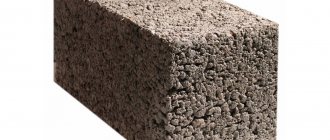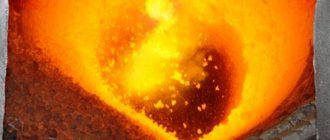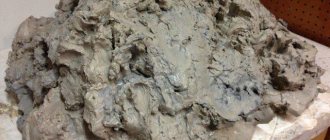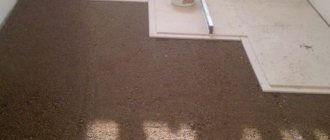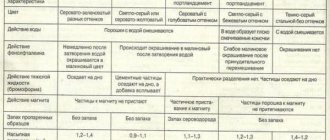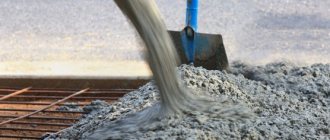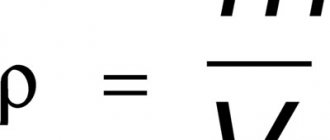The specific gravity of expanded clay is the weight of a cube of expanded clay. Weight of 1m3 of expanded clay and its density
Expanded clay, today, is one of the main components for the production of concrete. This is due to the fact that this type of material increases thermal insulation and increases the durability of concrete. However, the construction of high-quality and reliable structures requires accurate calculations. It is impossible to do the latter without analyzing the characteristics of building materials. Therefore, for proper preparation, it is extremely important to know exactly what the weight of expanded clay is.
The specific gravity of expanded clay refers to the ratio of the weight of solid dry particles to their volume. This parameter depends on several characteristics:
— Expanded clay grain size.
The specific gravity of expanded clay varies depending on the size of the fraction: the larger the grain, the lower the specific gravity. This can be seen using the example of expanded clay of density grade M600 in Table No. 1. Specific gravity and weight of expanded clay depending on the type and fraction
| Type of expanded clay | Specific gravity (g /cm3) | Expanded clay weight in 1 m3 (kg) |
| Fraction 0 – 5 mm, expanded clay sand | 0,55 – 0,6 | 550 — 600 |
| Fraction 5 – 10 mm | 0.4 – 0,45 | 400 – 450 |
| Fraction 10 – 20 mm | 0,35 – 0,4 | 350 – 400 |
| Fraction 20 – 40 mm | 0,25 – 0,35 | 250 — 350 |
Table of the weight of a cube of expanded clay depending on its density.
— Brand of density. Depending on the brand of density according to GOST, the specific gravity of m3 of expanded clay also differs: the higher the density of expanded clay, the greater the weight of the material in general. This can be traced, and you can also find out the approximate weight of a bag of expanded clay by density grade in table No. 2.
— Density of expanded clay.
Denser grades will have a specific gravity value higher than that of lower-strength expanded clay, due to low porosity. GOST also establishes various strength grades. Table No. 3 will help you calculate the strength and weight of the bag. Specific gravity and weight of a bag of expanded clay depending on the brand
| Density grade /Strength grade | Specific gravity (g /cm3) | Expanded clay bag weight (42 l) |
| M250 / P-25 | 0,2 – 0,25 | 8,4 – 10,5 |
| M300 / P-30, P-50 | 0,25 – 0,3 | 10,5 – 12,6 |
| M350 / P-50 | 0,3 – 0,35 | 12,6 – 14,7 |
| M400 / P-50 | 0,35 – 0,4 | 14,7 – 16,8 |
| M450 / P-75, P-100 | 0,4 – 0,45 | 16,8 – 18,9 |
| M500 / P-100, P-125 | 0,45 – 0,5 | 18.9 – 21 |
| M600 / P-125. P-150 | 0,5 – 0,6 | 21 – 25,2 |
| M700 / P-150, P-200 | 0,6 – 0,7 | 25,2 29,4 |
| M800 / P-200 | 0,7 – 0,8 | 29,4 – 33,6 |
| M900 / P-200 | 0,8 -0,9 | 33,6 -37,8 |
| M1000 / P-200 | 0,9 – 1 | 37,8 – 42 |
| M1100 / P-200 | 1 – 1,1 | 42 – 46,2 |
| M1200 / P-200 | 1,1 – 1,2 | 46,2 — 50,4 |
Average values of the specific gravity of expanded clay depending on its brand.
From the above it follows that it is almost impossible to determine the exact specific gravity of m3 of expanded clay ; too much depends on the exact characteristics of the material.
However, the average value is quite easy to establish. The average expanded clay indicator is generally 400 kg/m3 or 0.4 g/cm3, and the weight of the bag is ~16.8 kg. When calculating numerical indicators for each faction, you can create a table of specific values:
- Expanded clay fraction 0-5 ~600 kg/1m3 or ~0.6 t/1m3
- Expanded clay fraction 5-10 ~450 kg/1m3 ~0.45 t/1m3
- Expanded clay fraction 10-20 ~400 kg/1m3 ~0.4 t/1m3
- Expanded clay fraction 20-40 ~350 kg/1m3 ~0.35 t/1m3
However, these numbers are purely approximate, calculated without taking into account the brand of density, strength and provide the same value for accurately determining the amount of material, but give an approximate idea of the weight as a whole.
See also:
— area of application of expanded clay
naruservice.com
Expanded clay weight and how to correctly determine the required volume.
expanded clay. The stronger the thermal insulation is needed, the larger the fraction should be used.
For calculations of 1 cubic meter of expanded clay bulk weight it is accepted:
— fraction 20-40: — 350 kg;
— fraction 10-20: — 400 kg;
— fraction 5-10: — 450 kg;
— fraction 0-5: — 600 kg.
For unsorted expanded clay, this value is taken as 450 kg per m3.
Expanded clay block weight
How much does an expanded clay concrete block weigh? You will need to know the weight of the expanded clay concrete block to calculate the load on the foundation. This value depends on the brand of the block, including the type of expanded clay, mortar and configuration of the block itself. The weight of an expanded clay block is significantly affected by the presence of voids in the body of the block. Also, the weight of an expanded clay block is influenced by its standard dimensions:
— 200 x 200 x 400 mm;
- 100 x 200 x 400 mm.
Shapes of standard products that affect the weight of expanded clay blocks:
- two-hollow, four-hollow, seven-hollow;
- three-slot, four-slot, seven-slot;
- full-bodied.
The weight of the expanded clay block will depend on the brand and ranges from 5 to 20 kg.
Groups of expanded clay concrete by functionality:
Based on functionality and properties, expanded clay concrete is divided into 3 groups, in each of which the weight of expanded clay concrete will be within the following limits:
— thermal insulation, with a volumetric weight from 300 to 900 kg/m3;
— thermal insulation and structural, with a volumetric weight from 700 to 1400 kg/m3;
— structural, with a volumetric weight of up to 1700 kg/m3.
Weight of expanded clay of different fractions in 1 m3, characteristics, prices
Expanded clay refers to a lightweight, free-flowing building material made from baked clay or shale in the form of sand, cubic crushed stone, round or oval gravel. The size of the fractions varies from 0 to 40 mm, the specific gravity depends on the brand and varies from 250 to 1000 kg/m3. It is used as bulk insulation, lightweight concrete filler, decorative bedding or layer in drainage systems. Expanded clay is most often sold in cubic meters; when calculating the loads of building structures or the amount of material purchased, it is important to know how much one cube weighs.
Specific gravity of different fractions
This indicator characterizes the ratio of the mass of granules in a dry state to the volume they occupy; due to the porosity and irregular shape of the particles, it is always several times less than the true density. Technical requirements for expanded clay are regulated by GOST 9757-90, this standard distinguishes grades of gravel and crushed stone from 250 to 600 kg/m3 (by agreement between the customer and the manufacturer, the production of grades M700 and M800 for mixing heavy expanded clay concrete is allowed) and sand and sand-gravel mixtures from 500 up to 1000. In the first case, the size of the fractions varies from 5 to 40 mm, in the second - 0-10. For calculations, the following values of the volumetric bulk density of expanded clay granules are used:
| Filler type | Fraction size, mm | Volumetric weight, kg/m3 |
| Expanded clay sand | 0-5 | 600 |
| Round granules or crushed stone | 5-10 | 450 |
| 10-20 | 400 | |
| 29-40 | 350 | |
| Unsorted expanded clay | — | 450 |
Non-standard fraction sizes include mixtures of gravel or crushed stone from 2.5 to 10 mm and from 5 to 40 and sand-gravel from 0 to 10 mm. By default, the mass of 1 cube of such brands is assumed to be 450 kg. Unlike other types of fillers, the high specific gravity of expanded clay is not an indicator of its quality; rather, on the contrary: the larger it is, the lower the porosity of the granules and the worse their thermal insulation abilities. But it all depends on the purpose, each brand is used for a specific purpose, so, to create structural blocks, denser types are purchased, for filling material as insulation, the lightest, and, accordingly, large ones are purchased. The last condition is important to take into account both in terms of increasing the temperature resistance of building structures and in order to reduce weight loads.
You can learn about the weight characteristics of sand from this article.
Theoretically, the smaller the granules, the more 1 cubic meter of expanded clay weighs. But the possibility of changes in internal porosity due to deviations in firing temperature or other conditions should be taken into account. In practice, the only way to obtain the exact bulk weight of expanded clay is to weigh 1 cube. The last factor influencing the value of the indicator is humidity, but it is usually neglected. Burnt clay granules are considered relatively resistant to getting wet, water absorption varies within 8-20%, no more, the rate of moisture removal is not inferior to its absorption.
Material cost
Basic prices are shown in the table below. Each brand has its own purpose:
| Delivery format | Fraction size, mm | Delivery volume, m3 | Price, rubles | |
| Wholesale (from 5 cubic meters and above) | Retail | |||
| In bags | 0-5 | 0,04 | 125 | 130 |
| 5-10 | 105 | 110 | ||
| 10-20 | 0,05 | 80 | 85 | |
| 20-40 | ||||
| in bulk | 0-5 | 1 cube | 3000 | 3050 |
| 5-10 | 2150 | 2200 | ||
| 10-20 | 1350 | 1320 | ||
| 20-40 | 1330 | 1380 | ||
The cost of expanded clay is primarily influenced by the volume of supply: batches over 500 m3 are cheaper. The same applies to transportation services. In addition, the price depends on seasonality, method of shipment, cost of production and size of granules.
During delivery, the expanded clay is lightly compacted; the compaction coefficient agreed with the consumer is no more than 1.15. It is used when checking the volume of shipment of large quantities.
stroitel-lab.ru
Expanded clay weight in 1m3
Expanded clay is a material widely used in the construction industry. It has low weight and low thermal conductivity. This is a bulk material that absorbs and releases moisture well. It is characterized by optimal heat and sound insulation properties. Expanded clay is very popular in the market due to these specific performance characteristics. However, before purchasing material, you should decide on its brand, which determines its weight.
Specific gravity of expanded clay - kg per m3
Expanded clay is a building material used as insulation and for the preparation of lightweight concrete grades. Depending on the shape of the granules and their average size, three types of expanded clay are distinguished:
- sand with granule size up to 5 mm, used for preparing concrete;
- gravel with round granules up to 40 mm in size for the production of concrete, lightweight concrete blocks and as a thermal insulation material;
- crushed stone with granules up to 40 mm in size, predominantly angular in shape, used for sound insulation, creating concrete and concrete structures.
Specific gravity of expanded clay
To purchase expanded clay, calculate the loads on building structures created with its use, and in the process of manufacturing expanded clay concrete, you need to know the weight of expanded clay. It depends on many factors, even on air humidity (the higher it is, the greater the weight of the expanded clay). In the regulatory literature there are tables in which you can find the specific gravity of expanded clay in kg/m3 for different fractions, calculated as a result of dividing the weight of its granules by the volume they occupy. Knowing this parameter allows you to determine how much 1 m3 of expanded clay weighs. In practice, two specific gravity values are used:
- for expanded clay;
- for expanded clay concrete.
Density of expanded clay
How many kilograms of expanded clay are in one cube can be determined by the value of its bulk density, that is, by marking. Depending on the value of this parameter, expanded clay of different fractions is divided into 10 grades. For example, for expanded clay brand M400, the bulk density is 400 kg/m3. This means that the mass of expanded clay in 1 m3 is approximately equal to 400 kg. And for expanded clay brand M600 with a maximum bulk density of 600 kg/m3, the weight of 1 m3 will be 600 kg. It turns out that you can find out how much expanded clay in 1 m3 without measurements and using regulatory data - it’s enough to know its labeling. It should be understood that the higher the grade of expanded clay, the higher its strength, since an increase in specific gravity is associated with an increase in density, and with an increase in density, strength also increases.
Volumetric weight of expanded clay
Expanded clay is sold in bulk or in bags, and one cubic meter is used as a unit of measurement. Knowing how much a cube of expanded clay weighs, you can easily determine the weight of one bag or the entire sold batch of expanded clay. To calculate the required volume, the following volumetric weight values are used for various expanded clay fractions:
- 600 kg for granules with sizes up to 5 mm;
- 450 kg for expanded clay with granule sizes up to 10 mm;
- 400 kg if the granule size does not exceed 20 mm;
- 350 kg for expanded clay with maximum granule sizes (up to 40 mm).
Where to buy expanded clay?
Knowing how much 1 m3 of expanded clay weighs, you can accurately calculate the required volume and order its purchase from our company. We offer to buy expanded clay from us, since its quality meets all the requirements of GOST 9757 from 1990 and 32496 from 2013. We sell expanded clay by pick-up or by our company’s transport, in bulk, in bags or in big bags. Call and order delivery.
idealnerud.ru
Water absorption of expanded clay
Water absorption is a relative indicator. It is expressed as a percentage of the weight of dry gravel. During the initial period of operation, expanded clay grains have less water absorption. This is due to the fact that the surface layer of the granule is able to prevent water from getting inside at first. Thus, there is a close connection between the water absorption of expanded clay and its strength. The higher the strength, the lower the water absorption of the material - on average the correlation coefficient is 0.46.
When the need arises for thermal insulation, both outside and inside a room, the need invariably arises to purchase such a wonderful building material, which has excellent heat and sound insulation properties, like expanded clay. And here inexperienced builders have approximately the same question: how much expanded clay is in a cube and how to determine the volume of this material required for insulation? The emergence of this issue is not at all accidental, since many domestic manufacturing plants prefer to continue to produce these products in the old fashioned way, not in packaged form in separate bags, but in bulk. As a rule, the weight of expanded clay directly depends on the brand, its inherent level of density of the internal structure and humidity, as well as on the size of the fractions. As practice shows, the weight of 1 m3 of expanded clay varies from 200 to 400 kg. For a visual representation, in order to understand how much 1 cube of expanded clay weighs, we can say that it is 20 bags of 50 kg each, 25 bags of 40 kg each, or 40 bags of 25 kg each. If you don’t know how many kilograms of expanded clay are in a cube, you can now write down that 1 m2 contains 200-400 kg of expanded clay of different grades, densities and fractions.
Weight of expanded clay in 1 m3 of different fractions and brands, prices
The material is an ideal filler in lightweight concrete: being light in weight, it occupies large volumes, and its porosity makes it a good heat insulator. Blocks made from it speed up construction; masonry, and the structure itself, are cheaper.
Fractions and their density
Having undergone preliminary granulation and firing in a kiln, the sintered clay particles are of unequal size. Their value ranges from 0-40. Pellets of 0-5 millimeters are called sand; 5-40 - gravel, and if they are crushed - crushed stone.
There is a pattern: the smaller the fraction, the denser it is and, therefore, heavier, that is, it has a greater bulk weight.
| Name | Size, mm | Volumetric weight, kg/cub.m |
| Sand | 0-5 | 600 |
| Gravel | 5-10 | 450 |
| 10-20 | 400 | |
| 20-40 | 350 |
The numbers from the table are also called the specific gravity of expanded clay. This value is not constant, it is measured and calculated at each specific location during use. It depends on the particles with what properties were poured into one cubic meter. Granules from other fractions could have gotten into this volume, or their swelling was affected by different durations in the firing furnace, so only by weighing the cube, and not by calculations through density, where voids and pores are not taken into account in the calculations, can the weight of a cubic meter be determined.
It is precisely this volumetric bulk density that underlies the labeling of expanded clay. The following table shows its dependence on the mass of the cube:
| Brand | Ud. weight in g per cm3 | Weight 1 m3, in kg |
| M 1000 | from 0.90 to 1.00 | 901-1000 |
| M 900 | from 0.80 to 0.90 | 801-900 |
| M 800 | from 0.70 to 0.80 | 701-800 |
| M 700 | from 0.60 to 0.70 | 601-700 |
| M 600 | from 0.50 to 0.60 | 501-600 |
| M 500 | from 0.45 to 0.50 | 451-500 |
| M 450 | from 0.40 to 0.45 | 401-450 |
| M 400 | from 0.35 to 0.40 | 351-400 |
| M 350 | from 0.30 to 0.35 | 301-350 |
| M 300 | from 0.25 to 0.30 | 251-300 |
| M 250 | from 0.20 to 0.25 | 200-250 |
Although the brand does not determine the strength, but how much one cube of such material weighs, there is a relationship between these characteristics. After all, it is clear that a homogeneous substance, but with a high specific gravity, will be denser, and in solids this property is directly related to strength.
For expanded clay sand, grades are indicated from M500 to M1000. In fact, gravel is produced on an industrial scale up to M600, that is, with a bulk density of up to 500-600 kg/m3. Above this value, up to M1200, building materials are manufactured according to consumer order.
Price
Several factors influence prices.
1. Manufacturing plant. Each of them has different conditions: distance from raw materials or consumers, costs for clay procurement, energy availability.
2. Seasonality. They build mainly in the summer, which is when demand and prices increase.
3. Shipping method. Granules can be supplied in bulk or in bags. The buyer himself decides what is more appropriate for him: with large volumes of work, it is preferable to take it in bulk in cubic meters, if it is a little, it is better to buy it packaged, since no one will sell small quantities by weight. In small retail, goods are more expensive: this includes the cost of service and packaging. The bag weighs on average 18-20 kg.
4. Scope of delivery. With large quantities of goods, transport costs per unit of product are reduced, so the price per cubic meter is reduced.
5. Factions. Sand made from it will always be more expensive than gravel. The reason is simple: the density, and, therefore, the weight of expanded clay per unit volume is higher. Accordingly, so does the cost: more weight means higher price.
In what cases should you buy one or another assortment? Sand or fine gravel 5-10 is used for concrete screeds, block production and drainage of waterlogged soils. Expanded clay fraction 10-20 is needed for insulation of interfloor ceilings and floors. The largest, 20-40, is used for thermal insulation of hydraulic networks with cold and hot water; in this situation, two goals are pursued at once: the efficiency of heating mains increases and access to pipelines becomes easier. Roofs and basements of buildings are also thermally insulated with coarse gravel 20-40 mm.
Here are the average prices depending on supply volumes and fraction sizes (VAT is already included in them):
| Name | Over 5 m3, rubles | Over 20 m3, rubles | Over 100 m3, rubles |
| Loose, 5-10 mm | 3300 | 2600 | 2500 |
| Loose, 10-20 mm | 2300 | 1600 | 1540 |
| Loose, 20-40 mm | 2300 | 1600 | 1540 |
| In bags, 5-10 mm | 140 | 125 | 120 |
| In bags, 10-20 mm | 125 | 90 | 85 |
www.spets-stroy-portal.ru
How much expanded clay fits in a bag?
It all depends on the volume of the bag and the density of the expanded clay. Standard bags are produced mainly with round capacities: 25, 30, 40, 50 and 60 liters. The size of the grains determines the density of the embankment. The smaller the diameter, the more grains enter the bag, the heavier the weight. Accordingly, on the contrary, the larger the grain, the smaller the piece quantity and the lighter the purchase volume. If we talk about average values, then a 25 liter bag holds 12 kg of medium-sized bulk substance (that is, the volume in liters is twice the mass in kilograms). These same 12 kg are the 40th part of 1 m 3 of bulk goods.
How much does expanded clay cost in bags?
Of course, somewhat more expensive than bulk goods. The costs of packaging and filling determine the additional markup. Example:
1 m 3 fractions 20–40 mm costs 1,400 rubles.
A bag with a capacity of 50 liters is 0.05 of a cube.
This means that an unpackaged volume of 50 liters should cost 1,400 rubles. × 0.05 = 70 rub.
It is worth adding about 20% to the indicated price (the cost of packaging and the bag itself). 70 rub. + 70 rub. × 20%: 100% = 84 rub. This is a logically justified cost of high-quality expanded clay in a bag.
Often promotional prices surprise with their low thresholds. It is quite possible to find a good product that is in stock, and the seller sells it at cost. But it happens that catchy promotional offers turn out to be the result of a trick with the weight or quality of expanded clay. Therefore, you should be picky about a product that attracts you with an advantageous offer. Savings on the purchase of building materials can be a significant loss on the costly outcome of construction.
How much does a cube of expanded clay 10 20 weigh: the volume of the bag
Table 2. What is the specific gravity of expanded clay fraction 5-10 mm, the exact mass of the material in 1 cube, bulk density and volumetric mass of 1 m3, the table is compiled taking into account the brand of insulation by density.
The following grades of bulk density of expanded clay stone and crumbs (sand, gravel, crushed stone) are given: M 250, M 300, M 350, M 400, M 450. For each grade of bulk density, the specific gravity and mass of certain volumes in kilograms are indicated. Expanded clay gravel of fraction 5-10 is often called fine expanded clay gravel (ceramic gravel, ceramic gravel, light gravel), considering the fraction 5-10 mm to be fine gravel. In appearance in the photo, these are quite large grains, granules, round particles with a melted surface and pores inside, with a diameter of 5-10 mm. Round, smooth, without edges or sharp corners, the shape of the gravel resembles natural pebbles or natural pebble stone. What is the reason for another name (not GOST, household) expanded clay gravel - expanded clay pebbles of fraction 5-10. Thus, expanded clay pebbles are not a separate, special type of stone, but simply a common household folk or trade name for ceramic gravel.
Expanded clay of fraction 5-10, at manufacturing enterprises, at factories for its production, is made mainly in the form of expanded clay gravel. This is the most widespread commercially available material. This is exactly how most people imagine it externally; in almost all photos of expanded clay published on the Internet we see only gravel. Its grains have a round shape, so they are often called pellets, although from a technological point of view this is not correct, but it is very similar in appearance to the photo of expanded clay. The structure of expanded clay gravel 5-10 is porous, rough, not entirely smooth, and feels finely cellular to the touch. The surface of ceramic gravel 5-10 has a denser crust, the inside resembles pumice. The “natural” color of expanded clay gravel 5-10, made from clay, without violating production technology, is usually dark brown, more like brown.
It is interesting that the color of expanded clay gravel 5-10 changes when fractured. If the surface of the expanded clay is brown, what is inside, at the break, the color is darker, without a reddish tint, almost black or blackish-gray. Production technology. Expanded clay gravel of fraction 5-10 is made at the factory, and is obtained by swelling when firing low-melting clays in rotary kilns. According to its properties and physical characteristics, expanded clay gravel with grain sizes of 5-10 mm is frost-resistant, has low thermal conductivity and high thermal insulation qualities, is fire-resistant, does not absorb water (low water absorption) and does not contain impurities harmful to cement.
Expanded clay pebbles and expanded clay gravel of fractions 5-10 are used as insulation, heat insulator, insulator, bedding, backfill, insulation, plaster filler, aggregate in the production of lightweight concrete (monolithic lightweight concrete structures based on cement).
Expanded clay crushed stone of fraction 5-10 is fine crushed stone.
The name of expanded clay crushed stone is based on its characteristic shape, with corners, edges, breaks, plates, reminiscent of natural stone - natural crushed stone obtained by crushing rocks (granite, marble, limestone). In terms of color and characteristics, expanded clay crushed stone of a fraction of 5-10 mm does not differ from expanded clay gravel, but its shape does not visually look so good and is not associated with natural pebbles. Therefore, expanded clay crushed stone of fraction 5-10 is not used for decorative purposes, for example: for backfilling paths, in landscape design. The main use of expanded clay crushed stone of fraction 5-10 is associated with the use of insulation under a future screed as a backfill. And of course, expanded clay crushed stone 5-10 is also a filler for lightweight concrete. Its use makes it possible to produce lightweight and “warm” cement-based concrete structures using a monolithic method of any arbitrary shape. The weight of expanded clay of the 5-10 mm fraction is discussed in Table 1 and Table 2. REVIEWS.
How many beats weight of expanded clay fr 5-10 mm. Read reviews or leave your own review, comment on the topic: specific gravity of expanded clay of fraction 5-10. How many beats weight of expanded clay fr 5-10 mm. Please note that names such as expanded clay stone, pebbles, expanded clay chips, drainage, expanded clay backfill, mixture, expanded clay insulation, thermal insulation, expanded clay backfill, insulation, expanded clay granules, crushed clay, expanded clay pellets, expanded clay balls, are not official GOST definitions for bulk material. In fact, these are trade names or everyday definitions associated with advertising or the area of use of bulk material. From a physical point of view, GOST 9757-90 considers this to be varieties of expanded clay sand, expanded clay crushed stone and expanded clay gravel, based on the shape of the granules and their size corresponding to one of the fractions.
| What is the specific gravity of expanded clay fraction 5-10 (fraction 5-10 mm) in kilograms. A lot of the following types of bulk materials: expanded clay stone, sand, expanded clay insulation, crushed clay, expanded clay chips, gravel, expanded clay pebbles, thermal insulation, expanded clay backfill, crushed stone, expanded clay insulation, drainage, expanded clay backfill. General information: bulk cargo is a light porous material of cellular structure with low density, low water absorption, compacted surface, a characteristic stone-like shape in the form of gravel resembling natural, less often in the form of crushed stone similar to stone, produced on factory equipment by firing fusible clay rocks (clays) capable of swelling when rapidly heated to a high temperature. Clay heating temperature is from 1050 to 1300 degrees Celsius, heating time during production: 25–45 minutes. The quality of crushed stone and gravel is characterized by the size of its grains, bulk density (bulk density) and strength. Depending on the grain size in mm, expanded clay gravel and crushed stone are divided into the following fractions: 5 - 10, 10 - 20 and 20 - 40 mm, material with a grain size of less than 5 mm but more than 0.1 mm is classified as expanded clay sand. Material with a grain size from 0 to 0.1 is dust. Usually used in the form divided into fractions using special sieves, the dust fraction is removed. In some cases, the fractions are combined in the required proportions to create a mixture. The volumetric weight of a mixture of expanded clay fractions is calculated by proportion, in accordance with the share of each fraction in the mixture. | ||||
| The specific gravity of expanded clay of fraction 5-10 (fr. 5-10 mm) depends on the grade in terms of bulk density, grade in terms of strength and moisture content of the bulk material.The specific gravity of expanded clay of fraction 5-10 in 1 cube, 1 cubic meter, 1 cubic meter, 1 m3 is the bulk or bulk density. One of the important characteristics of bulk material (gravel, sand, crushed stone, pebbles, crumbs, crushed stones) is bulk density, which determines the specific gravity of expanded clay of fraction 5-10 in 1 m3 . Usually, for practical purposes and when performing construction work, it is measured in units such as kg/m3 or t/m3. The specific gravity of expanded clay is the weight of a cube of expanded clay. Weight of 1m3 of expanded clay and its densityMuch less often it needs to be known in units such as g/cm3. The most accurate values of the bulk density of expanded clay are always GOST. If we want to look at the characteristics of expanded clay of fraction 5-10 according to GOST 9757-90, then some “snag” will become clear with the bulk density. It turns out that GOST 9757-90 does not clearly regulate bulk density by fraction of expanded clay materials , but requires compliance only with grades of expanded clay bulk density. We are not entirely happy with this. Why? It would seem that we look at the markings on the container (bag), if the material is packaged, or we recognize the brand from the passport, certificate and can find out the exact specific gravity of expanded clay of fraction 5-10. Theoretically this is true, but practically there is one subtlety. The fact is that the brand of expanded clay material gives us fairly accurate characteristics of the volumetric mass of 1 cubic meter for the small fraction, for example: sand, crushed particles, crumbs. And for the medium and large fractions, additional adjustments are needed. The larger the expanded clay fraction, the lighter the bulk material, since there is a greater amount of air in the volume along with it, which reduces the mass of 1 cubic meter, with the bulk density of this brand declared according to GOST 9757-90. How to make such an adjustment yourself? Find out the exact specific gravity of expanded clay of fraction 5-10 for a specific batch of material is possible only by control weighing. Table 1. | ||||
| How much does expanded clay weigh 1 m3 ON AVERAGE. | How much does 1 liter (liter jar) weigh in kg? | How much does 1 bucket with a capacity of 10 liters (standard) weigh? | How many liters are in 1 cube (one cubic meter). | How many kilograms are in a cube - mass of 1 m3, volumetric density, beats. weight. |
. Pebbles, crushed stone, gravel.0.4 - 0.45 kg4 - 4.5 kg1000 l400 - 450 kg/m30.40 - 0.45 g/cm32.5 - 2.22 How much does expanded clay weigh 1 cubic? The exact value of the mass is 1 m3 according to GOST 9757-90.
| Sk. kilogram cubed - mass of 1 m3, bulk density, specific gravity. |
. Expanded clay gravel, pebbles and crushed stone. 200 - 250 kg/m30.20 - 0.25 g/cm35 - 4 Grain size from 5 to 10: fraction 5-10. Brand by bulk density M 300
. Expanded clay gravel, pebbles and crushed stone.251 - 300 kg/m30.25 - 0.30 g/cm34 - 3.33 Grain size from 5 to 10: fraction 5-10 Brand by bulk density M 350
. Expanded clay gravel, pebbles and crushed stone.301 - 350 kg/m30.30 - 0.35 g/cm33.33 - 2.86Grain size from 5 to 10: fraction 5-10. Brand by bulk density M 400
. Expanded clay gravel, pebbles and crushed stone.351 - 400 kg/m30.35 - 0.40 g/cm32.86 - 2.5 Grain size from 5 to 10: fraction 10-20. Brand by bulk density M 450
. Expanded clay gravel, pebbles and crushed stone.401 - 450 kg/m30.40 - 0.45 g/cm32.5 - 2.22
| © PE Kolesnik 2010-2011 Our address: Dnepropetrovsk, st. Karl Liebknechta 57 Phone in Ukraine: (063) 796-79-32 or (063) 796-19-32 |
stroyvolga.ru
Application in construction
Expanded clay sand. For the production of lightweight concrete blocks. The strength of its adhesion to the solution due to the rough surface is great, and the high density increases the strength characteristics of the blocks. It can also be suitable instead of regular sand for floor screeds, even under linoleum. The screed will be quite dense, strong and even. And for floor insulation they use fine, sandy expanded clay. Water and heat supply pipelines are also equipped (filled) with fine expanded clay. There is such a property as flowability, the ability to fill empty spaces between pipes.
Expanded clay gravel. It has a density lower than that of sand, but due to the different caliber parameters, the application is more extensive. Such expanded clay is often used for flooring, that is, pouring it, especially with 5-10 mm granules. This size of expanded clay particles is also suitable for floor screeding under any floor coverings. If you need a thicker floor screed, you will need larger gravel. If the particles are 10-20 mm, this is a good expanded clay for filling floors and insulating the inter-ceiling space. Here is an approximate table for gravel of different fractions:
| Design | Expanded clay fraction, mm |
| Roofs and roofs | 10-20 |
| Interfloor ceilings | 4-10 |
| Floors laid on the ground | 10-20 |
| Geotechnical | 10-20 |
Expanded clay crushed stone. It is a secondary product of expanded clay gravel. Therefore, if the size and angular shape allow, you can use it in the same way as gravel: in ceilings, roofs, basements, and attic floors. But most often it is used for insulating foundations, since it is the only one among crushed stones with a porous structure. Gravel with granules of 20-40 mm has the lowest density, so its thermal insulation properties are high. But due to the large particle size, such material is used for thermal insulation of floors located directly on the ground or roofs.
Expanded clay packaging from AKZ LLC
18.10.2016
Expanded clay is a granular bulk material that is used as a filler for concrete mixtures for thermal insulation of residential and industrial buildings as a raw material, in the manufacture of partition blocks and for many other purposes.
Depending on the volume of work performed, granules can be purchased in bulk or packaged in bags. In the latter case, the question often arises: how many bags are there in a cube of expanded clay?
To answer this question, it is enough to carry out simple mathematical calculations. For packaging the material, bags with a volume of 20, 30, 40 or 50 liters are usually used. If we consider that there are 1,000 liters in one cubic meter, then it is enough to divide this number by the volume of the bag to get the desired value. As a result, it turns out that in one cube of expanded clay:
- 50 bags with a volume of 20 liters;
- 33 bags with a volume of 30 liters;
- 25 bags with a volume of 40 liters;
- 20 bags with a volume of 50 liters.
Such simple calculations allow you to order the exact amount of material to perform certain work and choose the right transport for its delivery.
Another important indicator that you need to pay attention to when purchasing expanded clay is bulk density. Depending on this parameter, the material is classified into several grades, and it also determines the weight of one cubic meter. The most widely used in construction is expanded clay brand M250, a cube of which weighs about 250 kg.
It should be taken into account that material with a high bulk density has a denser structure and is more durable. More porous granules have a low bulk density and are excellent for thermal insulation.
To buy high-quality expanded clay, contact Aleksinsky Expanded Clay Plant LLC by phone +7 (920) 7-555-555.
www.keramzit-aleksin.ru
How many bags are there in a cube of expanded clay?
Among the materials used in construction, expanded clay has gained particular popularity. Today, without its unique properties, it is impossible to build a warm and cozy home. This material received all the useful characteristics due to its origin. The main raw material for its production is fusible clay, which lies at a depth of 5-7 meters. Before being presented to the consumer, it undergoes cleaning and crushing into the smallest particles, and then goes for firing. As a result of this process, expanded clay appears - a material in the form of sand or granules, which, in addition to construction, can be found in the most unexpected areas.
The increased demand for this material in the construction market is a stimulator for its sale. To purchase expanded clay, just look at Price Stroy. Here, expanded clay sand and granules packaged in bags await their customers.
What amazing properties does expanded clay have?
It won its niche in the building materials market for a reason.
- The environmental friendliness of the material makes it available for use both in housing construction and in other industries.
- Its lightness is incomparable to the lightness of similar materials. This property is especially valued in low-rise construction.
- The heat and sound insulating characteristics of expanded clay are predominant when choosing a material that can retain heat in the house and protect it from the penetration of sounds from the outside. Interestingly, a 10 cm layer of expanded clay is more insulating than a 1 meter thick brickwork, a 50 cm thick expanded clay concrete slab or a 25 cm layer of wood.
- Resistance to fungal growth makes it indispensable for use in damp conditions.
- It is a fireproof material.
The use of expanded clay is also justified by its long service life. Its strength and durability are several times higher than those of other materials.
How many bags are there in a cube of expanded clay?
The use of expanded clay has no restrictions. Due to its decorative properties, this material is a favorite of designers. It successfully replaces soils and soil mixtures for growing garden and vegetable crops. Not a single path laid out on dense soils, or a single treatment facility, can do without expanded clay.
But what if there is only loose material on sale, which is sold in large volumes, for example cubic meters? How to calculate in advance how many bags will be needed to deliver it?
The answer to the question posed lies on the surface:
- It is known that 1 cubic meter equals 1000 liters.
- The volume of the bag, depending on the size, can range from 30 to 40 and 50 liters.
- If you divide 1000 liters by the volume of one bag in liters, then the desired number will mean the number of similar bags in a cube of expanded clay.
The calculation for a 30 liter bag is as follows:
- 1000 : 30 = 33.333 (bags)
- For a 40-liter bag - 1000: 40 = 25 (bags)
- For a 50-liter bag - 1000: 50 = 20 (bags)
Knowing the exact quantity of containers for expanded clay is the key to economical purchase of the material.
https://price-stroy.ru/
samanka.ru
How much does a cube of expanded clay concrete weigh: specific, volumetric weight
Expanded clay concrete is used in the construction of external walls and ceilings. The material is lightweight and environmentally friendly, representing a subtype of lightweight concrete mass. Expanded clay concrete is considered completely safe; it is preferred in the construction of schools, children's institutions, hospitals, apartment buildings, and interior partitions. Walls made of such material are able to “breathe”, passing air masses through themselves, and do not accumulate moisture. The main component is expanded clay, to which binders are added in the form of cement mass, resin or gypsum. The blocks are durable, retain heat well indoors, do not react to temperature changes, and are easy to install. Today we’ll try to find out how much a cube of expanded clay concrete weighs in order to correctly determine the need for this material.
Specific gravity of one cubic meter of concrete
The most common way to classify the weight of a cubic meter of concrete mass is by specific gravity.
Taking into account the volumetric mass, concrete is divided into several types:
- Particularly light - the maximum weight of one cube does not exceed five hundred kilograms. Such concrete is characterized by the content of cells with air, the diameter of which is 1 - 1.5 mm, and a porous base. Such compositions include foam and gas block materials, which contain not only sifted sand and cement material, but also a foam former that forms air cells. This makes it possible to create a small mass and excellent thermal insulation abilities.
- Lightweight - concrete compositions filled with lightweight porous material. There may be no filler, but the structure of the mass still remains porous. A cube of material in this case weighs 500 - 1,800 kg, six hundred kilograms of which is sand - the main and essential element.
- Heavy is the most common type of mortar. It is used to make the main elements of the facility, screeds, fences, etc. The composition contains coarse fillers - sand, crushed stone, gravel, which account for the bulk of the material. A cubic meter of such concrete weighs from 1.8 to 2.5 tons.
- Particularly heavy - metal filler is used for its manufacture to give the finished product massiveness. One cube of material weighs from 2.5 to 3 tons. The composition includes a cement mass of increased strength. As a rule, special objects are built from such material.
As a rule, lightweight concrete is used in the form of a finished building block.
Mass calculation
There is a special formula to determine the weight of concrete and expanded clay concrete
g bs = V cr g env + V p g op + 1.15C, in which:
g bs is the expected maximum volumetric mass of expanded clay concrete in a dry state, expressed in kg/m. cube;
g surrounding and g op are the masses of coarse and fine filler, kg/m. cube;
V cr and V p - consumption amount of coarse and fine aggregate per 1 cubic meter of laid concrete composition, cubic meters;
C - the amount of binder per 1 cubic meter of laid expanded clay concrete, kg.
To determine the mass of a block, you need to know its shape, dimensions and weight of the materials used for production. And if you take a block with parameters 20 x 20 x 40 cm, then its mass will be from 6 to 29 kg.
Expanded clay concrete is usually divided into three subtypes:
- thermal insulation;
- structural;
- structural and thermal insulation.
The weight of expanded clay concrete is determined by the pore size of the filler and its quantity in the concrete mass.
Volume weight
The mass of materials used depends on the characteristics of their application:
- for the construction of an external wall;
- under the floor screed;
- for attic insulation.
When expanded clay concrete is used as an insulating material, sand should not be added. The composition includes cement mass, clean water, expanded clay stone of large and light fractions. The output is from 500 to 550 kg per cubic meter - exactly what is required to insulate the wall. Adding sand will add heaviness and reduce the level of thermal conductivity. To prepare one cubic meter of expanded clay concrete, you will need 280 kg of cement composition, the grade of which is m400. Knowing the initial data, you can determine how much a cube of m300 concrete with expanded clay weighs.
To produce lightweight expanded clay concrete, it is allowed to add sawdust of coniferous wood varieties to the mass.
The strength and weight of the material will depend on the amount of cement in expanded clay concrete.
To prepare the solution, you will need the following components:
- cement composition;
- washed sand;
- expanded clay stone;
- pure water;
- plasticizer additives in the form of liquid soap or washing powder.
The specific gravity of dry expanded clay concrete is the ratio of the weight of the dry material to the entire volume. It all depends on the size of the expanded clay grains. As already mentioned, the mass of expanded clay concrete is determined by the level of porosity of the material and the amount of its volume in the concrete mass.
The lightness of the components has an impact on reducing the costs associated with transporting the material and reduces the cost of the finished product.
Advantages and disadvantages
- Sufficient strength of the material.
- Low thermal conductivity, and as a result – good thermal insulation properties.
- It is a good sound insulator.
- High fire resistance defines this material as non-flammable and fireproof. When exposed to an external source of fire, it does not support combustion and does not emit harmful substances into the surrounding space.
- Frost resistance.
- Low specific gravity - allows you to use, if necessary, to reduce the weight of the building structures being constructed.
- Not exposed to atmospheric conditions (humidity, temperature changes).
- Inert to chemical attack.
- Does not rot or decompose.
- Long service life.
- It is an environmentally friendly material.
- Ease of installation work.
- Low cost compared to other heat-insulating materials.
- When laying in a horizontal plane, laying an underlying layer is necessary.
- If it is not manufactured well or is manufactured without the formation of a surface crust, it absorbs moisture, after which it cannot be used as a heat insulator.
- When used as insulation, it takes up a large volume, thereby reducing the space in the insulated room.
Due to its positive properties, expanded clay gravel is widely used in various types of construction work, such as:
- monolithic construction - used as filler;
- thermal insulation – these are roofs, floors and ceilings of buildings, structures and structures;
- thermal insulation of various systems - “warm floors”, water pipes, external heating pipes and other pipe systems.
- protection from noise of the internal space of premises;
- production of concrete and building blocks;
- thermal insulation of the foundation - allows you to reduce the depth of the foundation;
- road construction - used for thermal insulation and water drainage during the construction of embankments for roads and during construction in wetlands.
Expanded clay is also used when creating landscape design of a site (creating alpine slides and terraces), if necessary, thermal insulation of soil (when growing plants) and in plant growing - to create drainage of the root system of plants.
When choosing ceramic gravel, you must follow the selection criteria, which are:
- Quality of material.
- Availability of a certificate of conformity.
- Storage conditions for finished material.
- Integrity of fragments (grains) of material.
- Color and presence of crust on expanded clay grains.
